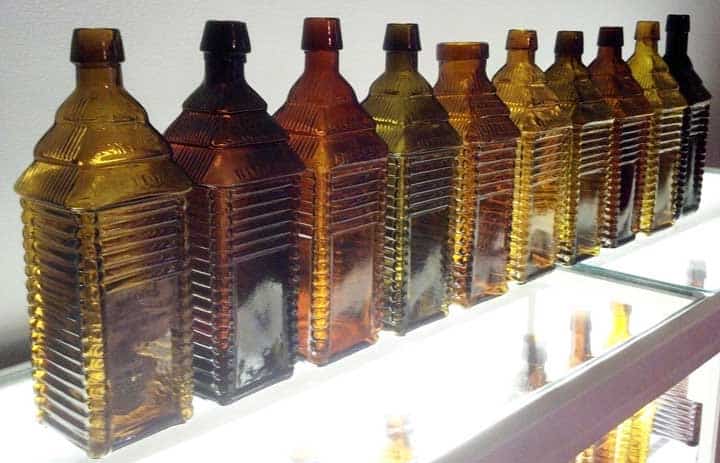
Drake’s Plantation Bitters mold variants (from left to right). D102, D103, D104, D105, D105.5, D106, D108, D108.5, D109, and D110 – Brian Shultis
Information on the Drake’s Plantation Bitters Variants
19 May 2012
Drakes authority Brian Shultis recently commented on facebook:
“There has been a lot of talk about Drake’s mold variants on here. I will post up a few comparison shots for those who don’t already know. Maybe it will interest a few collectors. First comparison is between a D 105 and D 106. Also, I noticed some of the auction houses don’t even list Drake’s by mold variant in their descriptions. Usually it is just listed as a 4, 5 or 6 log Drake’s”.
![]() This made me want to pull out my Carlyn Ring & W.C. Ham Bitters Bottles and Bitters Bottles Supplement books and look more closely at my bottles, of which I have many as I specialize in color runs. I have listed each Ring & Ham Drake’s variant along with a picture of the bottle, if available, for illustrative purposes.
This made me want to pull out my Carlyn Ring & W.C. Ham Bitters Bottles and Bitters Bottles Supplement books and look more closely at my bottles, of which I have many as I specialize in color runs. I have listed each Ring & Ham Drake’s variant along with a picture of the bottle, if available, for illustrative purposes.
Drake’s Plantation Bitters was a very successful brand, probably exceeded only by Dr. Hostetter’s Stomach Bitters. Because of the large number of these bottles that were produced in the 4, 5 and 6 log cabin designs, it is probable that many molds were used. A careful study of the bottles would undoubtedly identify additional molds. The 4 log variant is the oldest bottle. Information listed in Ring and Ham but can not be supported.
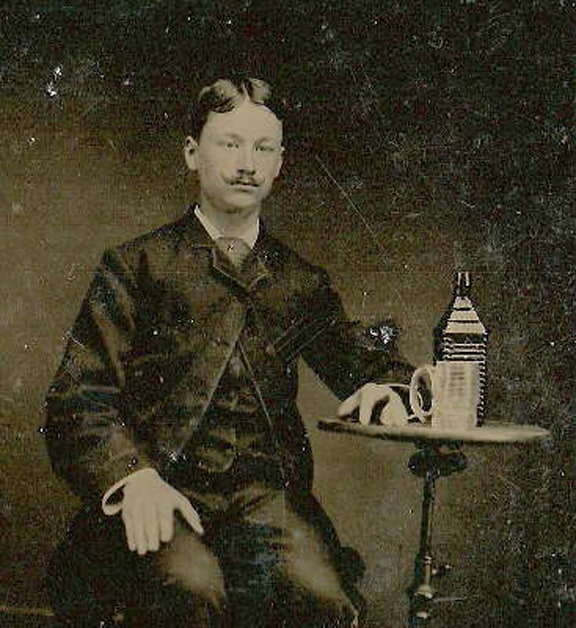
The gentleman pictured in the ca. 1870 tintype above was fond enough of the product to have his picture taken with it!
D 102
D 102 // s // motif arabesque / DRAKES / motif arabesque / PLANTATION / BITTERS enclosed in a rectangle // 3 tiers of thatching // tier of thatching/ PATENTED / 1862 / tier of thatching // 3 tiers of thatching //
10 x 2 7/8 (6)
Square cabin, LTC, Applied mouth, Amber, Puce and Amethyst-Rare;
Green-Extremely rare
17 logs including the base, 6 logs over the label panels
Read more: What is an Arabesque Drakes Plantation Bitters
D 103
D 103 // s // S T // DRAKE’S / 1860 / PLANTATION / BITTERS // 3 tiers of thatching // tier of thatching / PATENTED / 1862 / tier of thatching // 3 tiers of thatching //
10 x 2 7/8 (6)
Square cabin, LTC and LTCR, Applied mouth, Amber and Puce – Common;
17 logs including the base, 6 logs over label panels
D 104
D 104 // s // S T // DRAKE’S / 1860 / PLANTATION / BITTERS // 3 tiers of thatching // tier of thatching / PATENTED / 1862 / tier of thatching // 3 tiers of thatching //
10 x 2 7/8 (6)
Square cabin, Amber, LTC, Applied mouth, Rare
6 logs over label panel on all four sides
D 105
D 105 // s // S T // DRAKE’S / 1860 / PLANTATION / X / BITTERS // 3 tiers of thatching // tier of thatching / PATENTED / 1862 / tier of thatching // 3 tiers of thatching //
10 x 2 7/8 (6)
Square cabin, LTC, Applied mouth, Amber and Puce – Common;
Yellow olive and Green – Rare; Aqua – Extremely rare
17 logs including the base, 6 logs over label panels
D 105.5
D 105.5 // s // S T // DRAKE’S / 1860 / PLANTATION / X / BITTERS // 3 tiers of thatching // tier of thatching / PATENTED / 1862 / tier of thatching // 3 tiers of thatching //
10 x 2 7/8 (6)
Square cabin, LTC, Amber, Wide or expanded mouth, Extremely rare
D 106
D 106 // s // S T // DRAKE’S / 1860 / PLANTATION / X / BITTERS // 3 tiers of thatching // tier of thatching / PATENTED / 1862 / tier of thatching // 3 tiers of thatching //
10 x 2 7/8 (6)
Square cabin, LTC and LTCR, Applied mouth, Amber and Puce – Common;
Green – Very rare
17 logs including the base, 6 logs over label panels
Variation in the word Bitters with smaller letters and off center placement, Variation with line under Bitters
D 106.5
D 106.5 // s // S T // DRAKE’S / 1860 / PLANTATION / X / BITTERS // 3 tiers of thatching // tier of thatching / PATENTED / 1862 / tier of thatching // 3 tiers of thatching //
10 1/4 x 2 7/8 (6)
Square cabin, LTC, Applied mouth, Amber, Very rare
17 logs including the base, a vertical log one log high at each corner of base, 6 logs over label panels. There are two tiers of thatching on reverse. Embossing is larger and more bold than on the previous bottles. The log pattern around the base and corners are indented and distinctly rounded. Thatching and log pattern are very bold, and the 1860, X, and BITTERS embossing is larger and very bold.
D 107
D 107 // s // S T // DRAKE’S / 1860 / PLANTATION / X / BITTERS // 3 tiers of thatching // tier of thatching / PATENTED / 1862 / tier of thatching // 3 tiers of thatching //
10 x 3 3/4 (6 1/4)
Square cabin expanded to become bulbous, Amber, LTC, Rough pontil mark
Extremely rare
One known example which is believe to be unique
D 107.5
D 107.5 // s // S. T. // DRAKE’S / 1860 in thatching / PLANTATION in thatching / BITTERS in thatching // 3 tiers of thatching // tier of thatching / PATENTED / tier of thatching interrupted by 1869 raised and interrupting thatching / 3 tiers of thatching //
10 x 2 7/8 (6)
Square Amber, LTC, Applied mouth, Scarce
17 logs including the base, 6 logs over label panels
Roof embossing like D 108, roof configuration and base like D 105
D 108
D 108 // s // S T // DRAKE’S / 1860 / PLANTATION / X / BITTERS // 3 tiers of thatching // tier of thatching / PATENTED / 1862 raised and interrupting thatching / 3 tiers of thatching //
10 x 2 7/8 (6)
Square cabin, LTC, Applied mouth, Amber and Puce – Common;
Green – Very rare
17 logs including the base, 6 logs over label panels.
D 108.5
D 108.5 // s // S T // DRAKE’S / 1860 / PLANTATION / X / BITTERS // 3 tiers of thatching // tier of thatching / PATENTED / 1862 raised and interrupting thatching / 3 tiers of thatching //
9 7/8 x 2 7/8 (6)
Square cabin, LTC, Applied mouth, Amber, Extremely rare
17 logs including the base, 6 logs over label panels, base corners are chamfered on the bottom log.
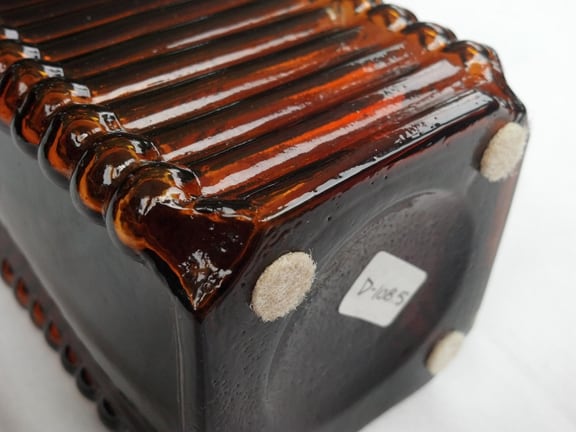
Base on a D 108.5 Drake’s (chamfered base corners). Apparently two known examples – photo Brian Shultis
D 109
D 109 // s // DRAKES in thatching / PLANTATION in thatching / BITTERS in thatching // 3 tiers of thatching // tier of thatching / PATENTED / 1869 / tier of thatching // 3 tiers of thatching //
10 x 2 7/8 (6)
Square, LTC and LTCR, Applied mouth
Amber and puce, Scarce, Green – Extremely rare
15 logs including the base, 5 logs over label panels
Date of reverse usually misread as 1862
D 110
D 110 // s // S T // DRAKE’S / 1860 / PLANTATION / BITTERS // 3 tiers of thatching // tier of thatching / PATENTED / 1862 interrupting thatching / 3 tiers of thatching
10 1/4 x 2 5/8 (6)
Square cabin, LTC, Applied mouth and Tooled lip;
Amber, Common; Yellow, Scarce; Yellow olive, Scarce
15 logs including the base, 4 logs over label panels
Tooled lip example known with 1898 date on label

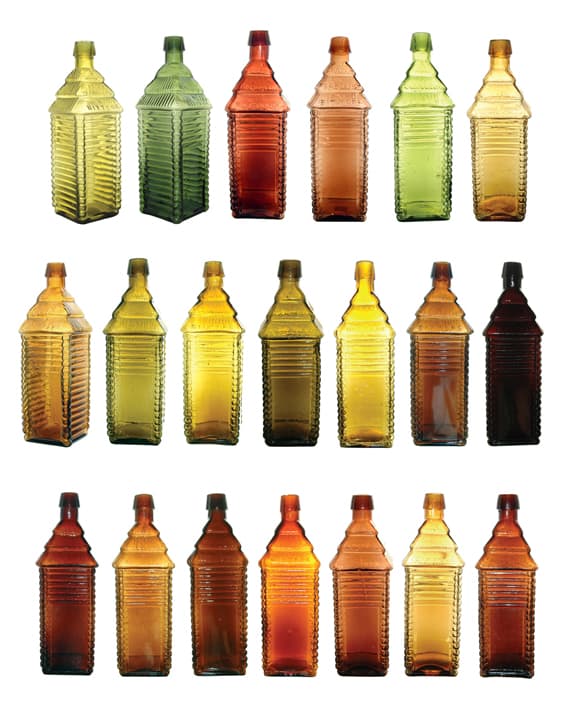
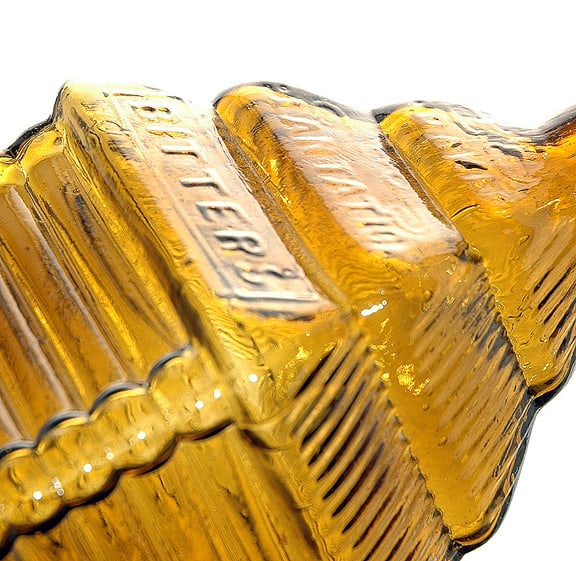
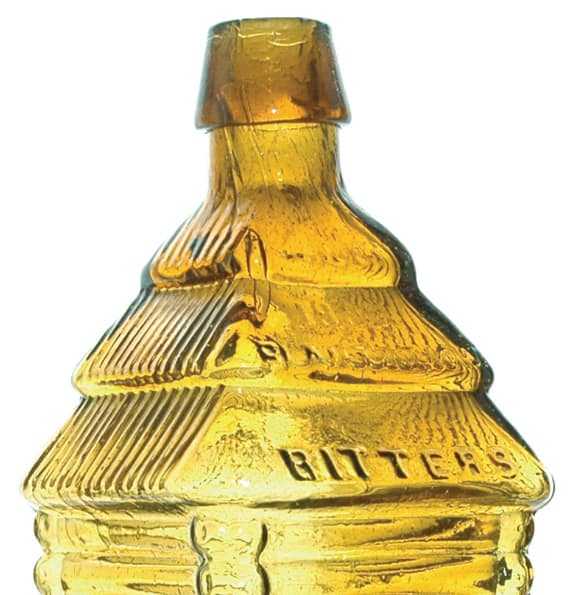
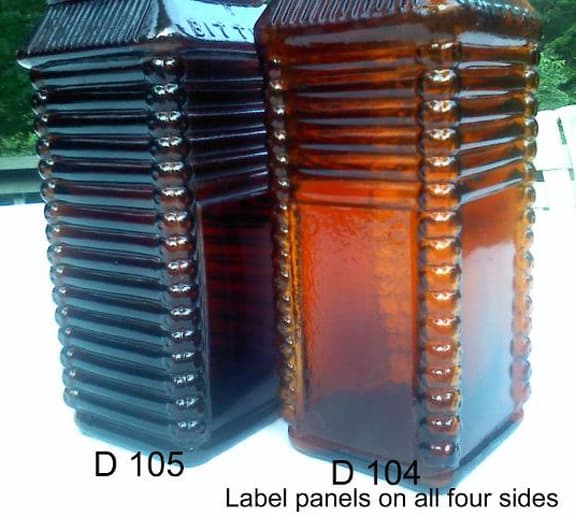
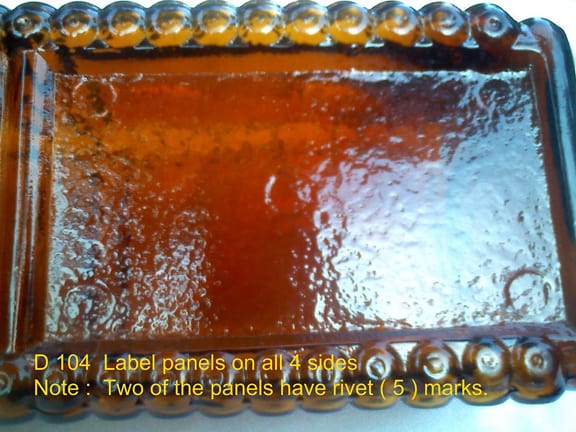
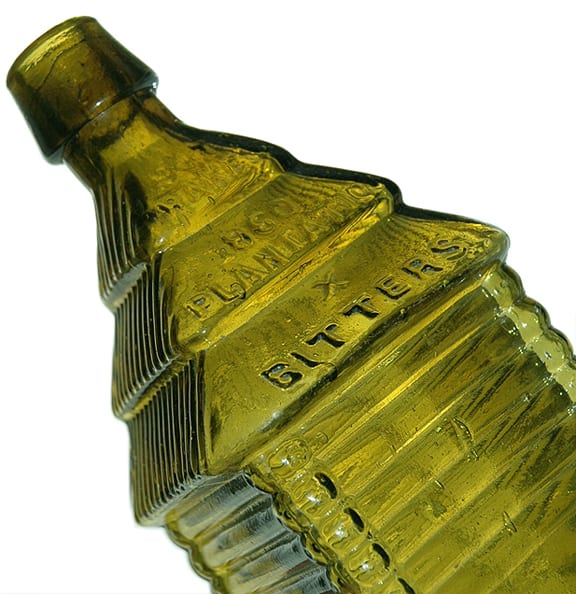
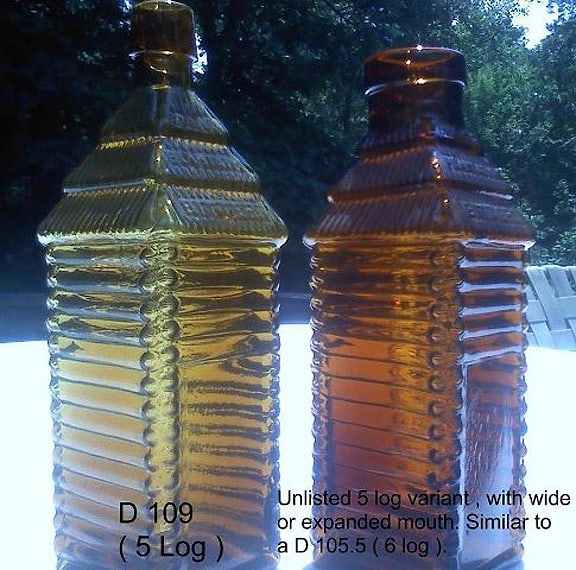
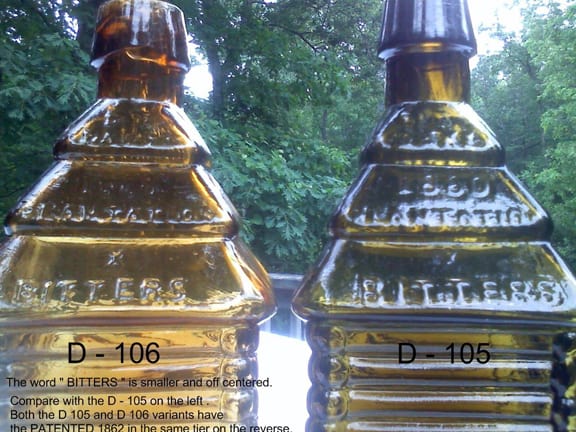
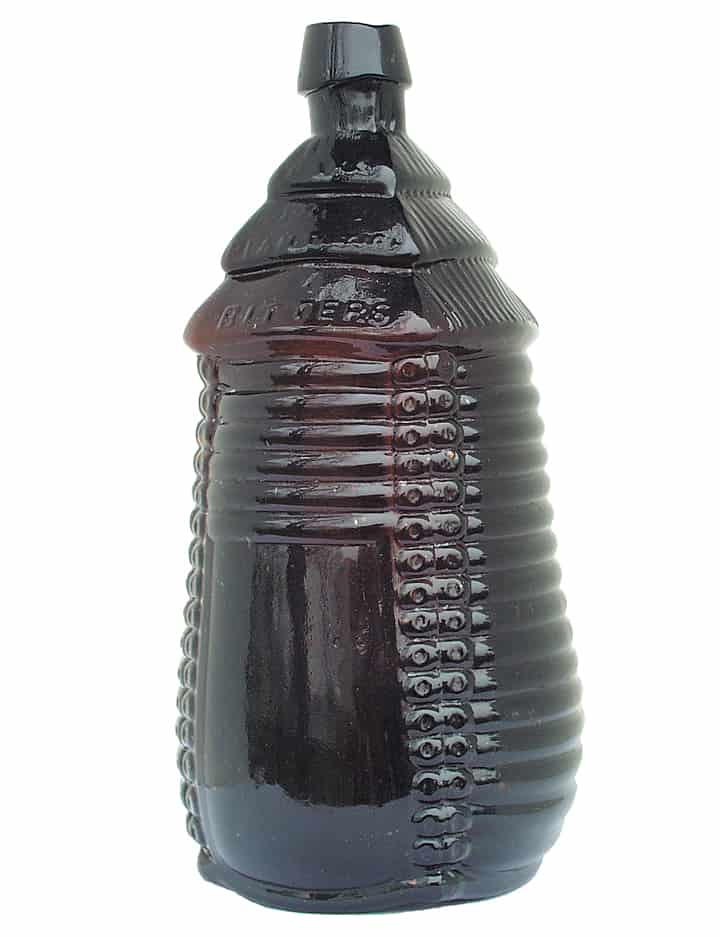
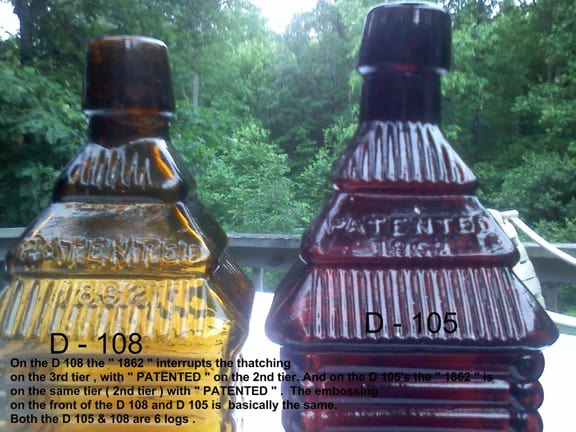
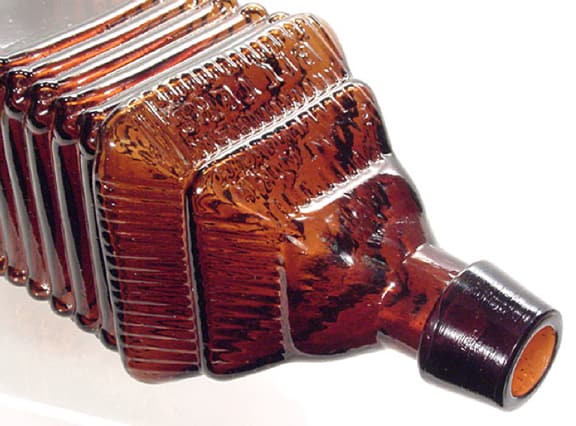
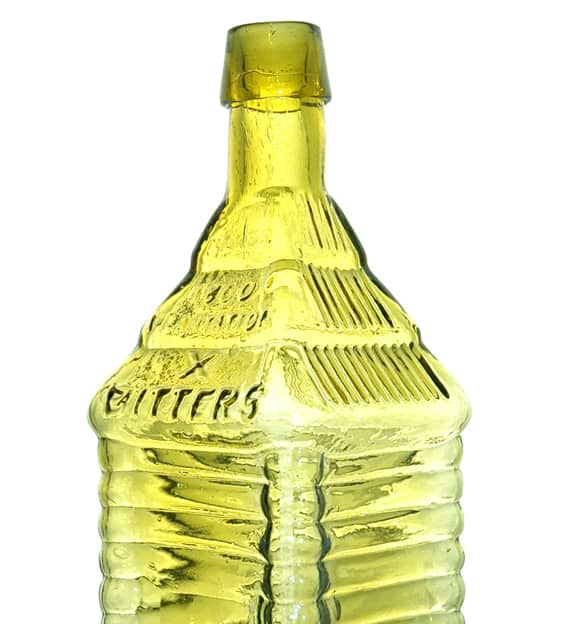






My question would be that in The beginning of the article it says that The 4 log is the oldest variation. Then towards the end its stated that the 4 log is known with a label dated 1898…. Just a bit of a contradiction…
Chris: I too found this interesting and worth questioning. In Bitters Bottle Supplement the tooled example is noted for the first time I believe, with a label nonetheless. I am asking Bill Ham for support behind the Ring and Ham information.
Chris:
Some communication from Bill Ham…
Ferdinand: The comment on it being the oldest is in the Supplement. I think that it came from something in Carlyn’s material she passed on to me. I was unable to find the source of the comment this morning. However, I have always wondered about it. Bill
Ferdinand
I have seen more than one tooled top example of the 4 log Drakes, and I have seen a labeled tool top example, don’t remember where, probably at a show. Since these bottles were probably recycled it becomes difficult to exactly identify how “new” a particular bottle may be. I’m not sure where the comment that the 4 log is the oldest came from. I do suspect that if one were to closely examine a large group of the S.T. Drakes Plantation Bitters bottles, additional molds would be identified. It is also interesting that the 3 examples of P108 PLANTATION BITTERS, that I am aware of, were all found in the West. Two came from the Portland, Oregon area, and one came from New Mexico. This has raised some speculation that it may be a western bottle. Bill
Thanks for the photos and the new information on the Plantation Bitter’s variants. Your Websise is reviewed almost daily to stay abreast of all the new information that is posted on this fasinating hobby of ours. I for one want you and Elizabeth to know that your efforts are greatly appreciated.
Bob Ferraro
Personally, I suspect that the earliest Drake’s are the unembossed varieties, which have the same general shape as the D-102 through D-110 Drake’s bottles but have no embossing at all. Some of the unembossed bottles have iron pontils and all versions are uncommon, although they do not command big money. The P.H. Drake & Co. proprietary stamp that was affixed to all embossed Drake’s bottles from 1862 through 1883, and was used to provide proof of payment of the federal revenue tax first imposed during the Civil War, depicts a detailed line drawing of an unembossed Drake’s. So, too, does the U.S. Patent Office drawing that secured a bottle-design patent for Drake on 2/18/1862: same shaped bottle but unembossed. (The Ring/Ham book shows the patent drawing in the main volume at page 204.) On another note, I heartily second Bob Ferraro’s comment: great site, Ferd and Elizabeth! I also check it out every day.
I have talked about the NON embossed cabins with Jeff Noordsy . It is quite possible that the pontiled non embossed Cabins were a copy cat bottle of the famous Drake’s brand. Jeff mentioned that some factories were still producing pontiled bottles well into the 1860’s .
On a different note . I would love to examine the 150 Drake’s that came off the shipwreck the S.S. Republic , which was a Civil War-era sidewheel steamship that sank during a hurricane in October 1865 . I have seen several of the bottles from the shipwreck and I saw a D 106 , D 105 , and a D 108 variants.
What Jeff thinks is quite possible. Myself, I really need to see some more pictures. I think I have only seen the base? Didn’t you mention that Steven had an example? Why don’y you do a story on the shipwreck Drakes?
I will ask Steven.
Mine was used in a trade and I no longer own it.
I don’t really have enough info to do a story on the Republic Drake’s . The Odyssey group is not very free with info , well not to me anyway .
The EARLIEST Drakes is said to be, not a cabin, but the iron pontiled ladies leg, BROWN & DRAKE/ CATAWBA BITTERS/BINGHAMPTON N.Y. Of the three known examples, I have in my collection one of the two found by the late Lockport New York collector, Alan Spear. I cannot remember what book cites this “leg” being the forerunner to the cabins, but if so, then P.H. Drake had to have partnered with someone named BROWN, prior to the cabins production. Who was BROWN? Are there any known examples of IRON PONTILED Drakes-embossed cabins?
The manufacturer of Drake’s, Catawba Bitters, was started by Patrick H. Drake, and a partner, Jerome B. Brown, in 1858. By 1859, Drake was the sole manufacturer of Catawba Bitters.
Very interesting. My only further thought is this: P.H. Drake went to the time, trouble and expense of obtaining a U.S. patent for his cabin-shaped bottle in early 1862; both the patent drawing and the tax stamps he used for the next twenty-odd years depict an unembossed cabin bottle (which, except for the embossing, is otherwise identical to the embossed Drake’s bottles). Is it logical that he would have tolerated blatent copy-cat bottles, in violation of his patent?
All the unembossed bottles I have seen have had some differences from the Drake’s mold. I would love to see one that is eactly like the Drake’s mold minus the embossing. Do you have one that you would share pics of ?
I have all the almanacs , the trade card , and the 100.00 dollar advertising note. All have embossed bottles on them except the bank note. I just presumed it didn’t show embossing because the bottle on the note was so small in size . I would guess that would be the same reason the tax stamp bottle doesn’t show embossing on the bottle. As far as the Patent …… he might have not known what was going to be embossed on the bottle at the time he applied for the patent ( just a guess ) . But just was patenting the cabin shaped bottle. I have not seen many of these unembossed Drake’s type molds , so I presume they are not common. Very interesting discussion .
You’re right about the existence of slight variations in the unembossed Drake-like bottles, and no, I haven’t seen one that’s identical to the embossed Drake’s. And here’s one further thought: perhaps the reason the unembossed Drake’s lookalikes are uncommon is that P.H. Drake did, in fact, sue to enforce his patent. In light of the similarity of the unembossed bottles to Drake’s patent drawing, he likely would have quickly won an injunction stopping the lookalikes.
Exactly my thoughts ! I wish we could find a labeled example out there . It would answer alot of questions for sure .
Jeff , There are no known pontiled embossed Drake examples other than the unique D 107 in the Cabin bottles .
I had one of the iron pontiled non embossed Cabins. It is very similar to the Drake’s , but it has some differences . One difference is all the examples I have seen had a LTCR lip treatment. And they don’t have the log corners ( hard to explain this without a pic ) , they have smooth corners . I will see if I can dig up some old pics.
Also , if I am remembering correctly . It only had one label panel ( non embossed example ).
I have to correct my statement earlier …… I had a LTC ( same as the Drake’s )and not a LTCR.
Post updated with top picture of entire run of Drake’s Plantation Bitters mold variants from Brian Shultis.